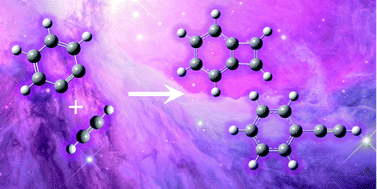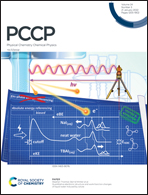Formation of phenylacetylene and benzocyclobutadiene in the ortho-benzyne + acetylene reaction†
Abstract
Ortho-benzyne is a potentially important precursor for polycyclic aromatic hydrocarbon formation, but much is still unknown about its chemistry. In this work, we report on a combined experimental and theoretical study of the o-benzyne + acetylene reaction and employ double imaging threshold photoelectron photoion coincidence spectroscopy to investigate the reaction products with isomer specificity. Based on photoion mass-selected threshold photoelectron spectra, Franck–Condon simulations, and ionization cross section calculations, we conclude that phenylacetylene and benzocyclobutadiene (PA : BCBdiene) are formed at a non-equilibrium ratio of 2 : 1, respectively, in a pyrolysis microreactor at a temperature of 1050 K and a pressure of ∼20 mbar. The C8H6 potential energy surface (PES) is explored to rationalize the formation of the reaction products. Previously unidentified pathways have been found by considering the open-shell singlet (OSS) character of various C8H6 reactive intermediates. Based on the PES data, a kinetic model is constructed to estimate equilibrium abundances of the two products. New insights into the reaction mechanism – with a focus on the OSS intermediates – and the products formed in the o-benzyne + acetylene reaction provide a greater level of understanding of the o-benzyne reactivity during the formation of aromatic hydrocarbons in combustion environments as well as in outflows of carbon-rich stars.

- This article is part of the themed collection: Festschrift Ivan Powis: Advances in Molecular Photoelectron Spectroscopy: Fundamentals & Application


 Please wait while we load your content...
Please wait while we load your content...